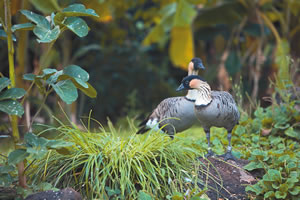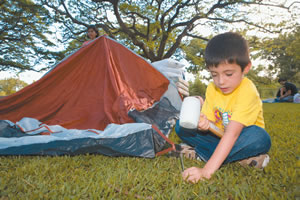A Night At The Zoo
Even for Honolulu Zoo regulars, it’s a totally different experience spending the night camped out there

By .(JavaScript must be enabled to view this email address)
E-mail this story | Print this page | Archive | RSS

|
When I told my husband, James, we would be spending the night at the zoo for the Honolulu Zoo Society’s Snooze in the Zoo program, let’s just say his reaction wasn’t quite as enthusiastic as the jump-up-and-down response I received from my 3- and 6-year-old daughters, Kylie and Taylor.
He does enjoy the casual zoo excursion. Since purchasing our membership earlier this year, our zoo outings have increased from about once a month to twice. And we even had Kylie’s birthday party there last year. So he’s kind of had his fill.
Me? I love the zoo. But I do have to admit that the idea of sleeping in a tent had me on edge. Still, I put those minor issues aside and focused on the positive. Mostly, I was intrigued to see the animals at night and excited that our girls would have their first experience sleeping outdoors.
So we packed up the car with a tent, blankets, pillows, sleeping bags, flashlights, a few changes of clothes, toiletries, snacks and water. I even ditched my makeup bag and the kids’ portable DVD player in an effort to keep the experience as authentic as possible.
We arrived at the zoo at 5:30 p.m. Friday, as instructed. There waiting for us were Honolulu Zoo Society instructors Jason Harris, Jason Tesman, Marisa Lee and Monica Szczupider, and lots of excited families.
We all waited anxiously for everyone to arrive, many with their futon mattresses in tow. It was then that I instantly regretted not bringing ours. It was an idea that I fancied but opted out of in fear of looking like I couldn’t rough it. I should have known there would be more like me.
After providing us with a few basic instructions, we were led onto zoo grounds, more specifically the grassy lawn area neighboring the Keiki Zoo and tiger cages.
“Pick a spot and start setting up your tents,” instructed Szczupider.
Everyone hustled to find a suitable spot, and the unfolding of tents began. Slowly tents began to take form, but not ours. Having borrowed the tent from a MidWeek co-worker, it was a learning experience.

|
My husband’s patience and knack for following directions got us through it. Well, that and the help of myself, our photographer Leah Ball and our two little ones (sort of). They mostly were given tasks to keep them occupied so they wouldn’t hinder the efforts of their very determined daddy.
I was secretly hoping we wouldn’t be last to put up our tent, thus holding up the rest of the group from taking the scheduled tour. Our team-work paid off - we finished in time for the tour and avoided being last. Secret mission accomplished.
Next up was the early evening tour that had us visiting the Komodo dragon exhibit, the Hawaiian hawk and the nene. It was great to hear all the neat facts about these animals, mostly things I never knew. It was at this point that James, who was obviously as intrigued as I was with all this information, turned to me and said, “Isn’t it crazy how little the average person knows about animals?”
Then it was time for dinner, one of my favorite times of day - the others being breakfast and lunch. I was surprised and delighted with the wonderful buffet-style spread of food - rice, tossed salad, fruit salad, pasta, shoyu chicken, pizza and chocolate chip and oatmeal cookies.
Everything I tried was great! And I even took the advice from Harris and opted for the oatmeal cookie instead of the chocolate chip. He was right on; the oatmeal cookie almost had me grabbing seconds - almost.
After dinner, the instructors gathered the group for a quick rundown on the evening’s activities and to pass out the special animal-friendly flashlights with infrared lenses. Since our Snooze in the Zoo group was rather large, they had us split into two groups for the late-night tour - one group went with Tesman, the other with Szczupider. We were in Szczupider’s group.

|
With flashlights in hand, we began our trek around the zoo. Our first stop was the tiger habitat, where we watched as Djelita, one of the Sumatran tigers, slept. As the kids peered through the glass at the amazing sight of a tiger sleeping in front of them, Szczupider spoke about the rare breed and its battle with extinction. Once widespread in Bali and Java, this subspecies now has fewer than 400 individuals in the wild, and just 69 in captivity in the U.S. Lucky for Hawaii, our Honolulu Zoo has six - Djelita, Berani, Chrissie and the new cubs Malosi, Keahi and Tondi, who were born last year.
Most important, the Sumatran tigers are critically endangered. Szczupider explained the importance of keeping animals such as the Sumatran tigers alive by making small changes. She spoke of deforestation to produce palm oil, and the deadly effect it has on rain forests and habitat for animals such as the Sumatran tiger.
The next animal on our tour was the gharial.
It was very embarrassing yet great to know that what we were once telling our children were crocodiles are actually not crocodiles, they’re gharials - a species in the crocodilian group.
Although they look similar to their reptile cousin, we were enlightened with a simple way to tell the difference: Gharials have a narrower body and snout, and they can’t pick up their bodies to walk on their legs.
Next we visited their other reptile cousin, the alligator, then the elephants (Mari and Vaigai), who were adorably fast asleep next to each other. And last on our tour were the white-handed gibbons and the spider monkeys. The spider monkeys were the most active of the bunch we’d seen and really welcomed the attention.
“There’s something nice about being in the zoo at night,” said Tesman. “When you come into the zoo at night it’s cooler, more relaxing and nothing is rushed. Our Snooze program is about 15 hours, so you really get to enjoy and see a lot of the animals. And we break it up into three tours so it is not overwhelming.”
We arrived back at the camping area with the s’more station all ready. The kids (and some adults) rushed to grab their sticks and marshmallows and head for the fire pit. I was one of those adults. My thought process: I didn’t get that second cookie during dinner, so I could splurge on a s’more, right?
Problem is that Taylor’s two front teeth are ready to fall out and she wasn’t able to eat hers. So guess who just had to eat it?
Two s’mores and three cups of water later I was ready for bed. We headed back to the tent to gather our teeth-brushing supplies and made our way to the restroom.
Once back in the tent, I gathered all my energy from the excess sugar I just devoured to tell the girls a few bedtime stories before falling asleep.
We were to get a 6 a.m. wake-up call, but the calls from all the animals started well before that - I was awake from about 2 a.m.
When I asked Tesman what exactly I heard, with a laugh he said, “Peacocks, tigers, argus pheasants and hyenas.”
I gathered that he gets that question a lot.
I made a beeline for the coffee as James began taking down our tent, and the girls enjoyed the playground with some of the other kids.
Breakfast was up next. And the buffet menu was as impressive as dinner: rice, fruit salad, scrambled eggs, bacon, Spam and pancakes - lots of fuel to get us through our morning tour.
The behind-the-scenes tour began with a walk through the back of the Safari area, through the “Jurassic Park” gates. From there we were introduced to the elephant habitat that’s currently under construction and tentatively scheduled to open in 2012. Next we saw the holding area for the elephants, where Mari and Vaigai enjoy their time away from the public eye. And then the most memorable stop on our journey - the poop pile. That’s right, a huge area for herbivore poop, which we were told is predominantly elephant. With the help of a bulldozer to turn it, we’re told that in time that pile turns into some of the best fertilizer. It’s all part of the zoo’s way to further practice conservation. The fertilizer is used for landscaping on zoo grounds, and the rest is available for public use.
Our next stop was to see
Page 1 of 2 pages for this story 1 2 >
E-mail this story | Print this page | Comments (0) | Archive | RSS
Most Recent Comment(s):








